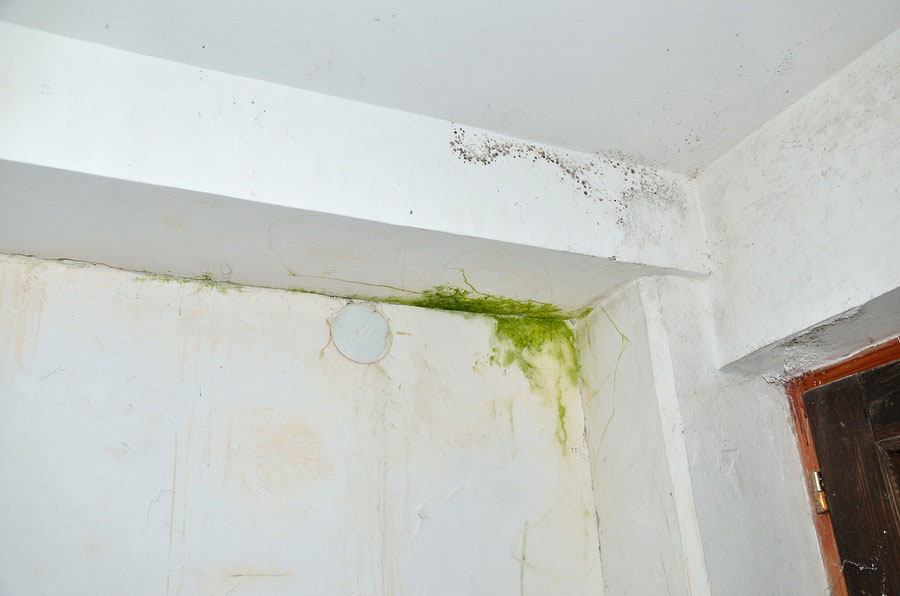Most people think of air pollution as an outside condition like smoke or smog. However, what people don’t realize is that the air inside your home can be more polluted than the outside air! Indoor pollutants can include lead from old paint, formaldehyde, fire retardants, radon or volatile chemicals from household cleaners.
One major pollutant that can cause all kinds of health problems is mold or mildew. Mold in a home can make you sick, especially those who have allergies or asthma. Occupants of a house may be experiencing symptoms of colds and allergies, when the cause is actually mold spores inside the home.
Mold forms where there is excess moisture. If there are wet spots on the ceiling or walls and that unsightly green slime is growing, you need to find the source of moisture and stop it. A leaky roof or a clogged gutter system is the likely culprit.
EPA Recommendations
Give your roof a thorough inspection for leaks and check to make sure your gutter system is working properly. If your gutter is clogged, water can be backing up and leaching into your walls and ceilings. If this is the case, add a leaf filter or gutter cover to prevent debris from stopping up your gutter system.
Let’s look at some other things we can do to improve the quality of the air we breathe in our homes, and improve the health of our families.
According to the EPA, there are three basic strategies to improve indoor air quality.
- Source control
- Improved ventilation
- Air cleaners
Source Control
Controlling the source is the first and most basic thing that can be done. Determine what the individual sources of pollution are and eliminate or reduce their emissions. Sources can be common household items such as:
- New carpet – emits a range of volatile organic compounds (VOCs).
- Broken compact fluorescent lights – emit mercury, a neurotoxin, in small amounts into the air.
- New electronics and other plastic products made with polyvinyl chloride – can emit phthalates.
- Glues and adhesives – emit VOCs such as acetone or methyl ethyl ketone.
- Heating equipment such as stoves, heaters, fireplaces and chimneys – especially gas stoves, can produce carbon monoxide causing, headaches, dizziness and fatigue.
- Upholstered furniture and pressed-wood products.
- Radon – from earth and rock under buildings or from private wells.
These types of indoor air pollution can be controlled in several ways: by covering them up, removing them completely or, in the case of heating equipment, adjusting them to release fewer pollutants.
Improved Ventilation
As we said earlier, outdoor air is often cleaner than indoor air. Introducing outdoor air is one way to improve your home’s air quality. This can be done in several ways:
- Natural ventilation – such as through windows and doors.
- Mechanical means – such as through outdoor air intakes associated with the heating, ventilation and air conditioning systems.
- Fans – window, ceiling, attic and bathroom fans.
- Infiltration – air that passes through openings, joints and cracks in walls, floors and ceilings, and around windows and doors.
Air Cleaners
Air cleaners range from complex whole-house systems to simple tabletop models. Some of these air cleaners can be very effective at removing particles, but most tabletop models are not that effective. Moreover, most air filtrations systems don’t remove gaseous pollutants such as carbon monoxide or VOCs.
Carefully evaluate if there may be outdoor sources of pollutants nearby, such as smoke or refuse, when using ventilation to reduce indoor air pollutants.
Breathe Easier with a Leaf Filter
Usually, the most effective way to improve indoor air quality is to eliminate the individual sources of pollution or to reduce their emissions. Do a thorough evaluation of your home and eliminate or control as many of the sources as you can. Then add some ventilation and effective air filtration. The air you breathe is very important to the health of you and your family. Don’t overlook moisture as a possible source of pollutants, as it often a major cause of health issues. Remember: a leaf filter or gutter cover can solve moisture problems that cause mold, a source of indoor air pollution. Call (800) 824-3772 to schedule a free, in-home quote with your nearest Gutter Helmet® dealer for gutter protection solutions.

